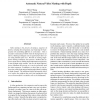Free Online Productivity Tools
i2Speak
i2Symbol
i2OCR
iTex2Img
iWeb2Print
iWeb2Shot
i2Type
iPdf2Split
iPdf2Merge
i2Bopomofo
i2Arabic
i2Style
i2Image
i2PDF
iLatex2Rtf
Sci2ools
107
Voted
PG
2007
IEEE
2007
IEEE
Automatic Natural Video Matting with Depth
Video matting is the process of taking a sequence of frames, isolating the foreground, and replacing the background with something different in each frame. This is an under-constrained problem when the background is unknown. Matting techniques exist to approximate these values using manual input cues. We look at existing singleframe matting techniques and present a method that improves upon them by adding depth information acquired by a time-of-flight range scanner. We use the depth information to automate the process so it can be practically used for video sequences. In addition, we show that we can improve the results from natural matting algorithms by adding a depth channel. The additional depth information allows us to reduce the artifacts that arise from ambiguities that occur when an object is a similar color to its background.
Related Content
| Added | 04 Jun 2010 |
| Updated | 04 Jun 2010 |
| Type | Conference |
| Year | 2007 |
| Where | PG |
| Authors | Oliver Wang, Jonathan Finger, Qingxiong Yang, James Davis, Ruigang Yang |
Comments (0)

